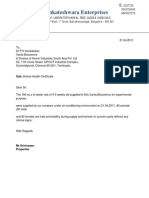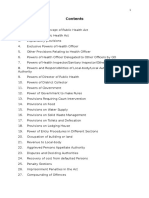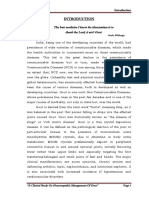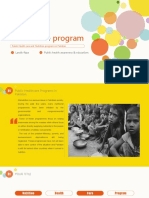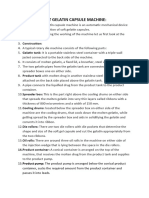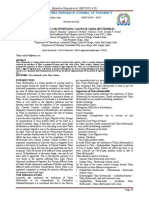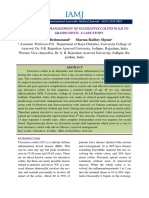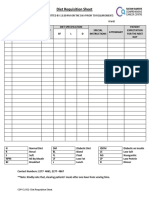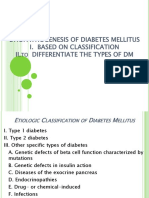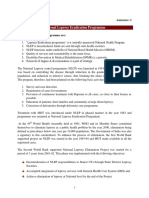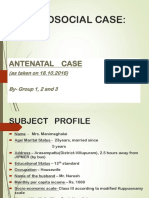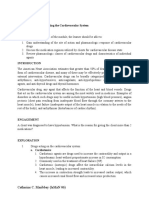Patient Information Leaflet - Diabetes Mellitus
Patient Information Leaflet - Diabetes Mellitus
Uploaded by
Catalina NegranzaCopyright:
Available Formats
Patient Information Leaflet - Diabetes Mellitus
Patient Information Leaflet - Diabetes Mellitus
Uploaded by
Catalina NegranzaOriginal Title
Copyright
Available Formats
Share this document
Did you find this document useful?
Is this content inappropriate?
Copyright:
Available Formats
Patient Information Leaflet - Diabetes Mellitus
Patient Information Leaflet - Diabetes Mellitus
Uploaded by
Catalina NegranzaCopyright:
Available Formats
Patient information leaflet - Diabetes mellitus
1.What is diabetes? Diabetes means that your blood glucose [often called blood sugar] is too high. Your blood always has some glucose in it because your body needs glucose for energy for its normal function. But too much glucose in the blood is not good for your health. 2. How do I get high blood glucose? After we eat, food is broken down in the stomach into sugars. The main sugar is called glucose. This is absorbed through the stomach wall into the blood stream. However to remain healthy your blood sugar should not be too high or too low. Insulin is a hormone secreted from pancreas that monitors your blood glucose level. When your blood glucose begins to rise [after eating], the level of insulin should also rise. Insulin acts on the cells of your body and makes them take in glucose from the blood stream. Some of the glucose is used by the cells for energy, and some is converted into glycogen or fat [which are stores of energy]. When the blood glucose level begins to fall [before meals or when we have no food], the level of insulin falls. Some glycogen or fat is then converted back into glucose and is released from the cells into the blood stream. Diabetes develops when there is shortage of insulin or available insulin does not work properly on the target cells. 3.What are the different types of diabetes? Type I diabetes: This type of diabetes is also known as Insulin Dependent Diabetes Mellitus or Juvenile Diabetes. This can occur at any age but occur more commonly in children, teenagers or young adults. In this condition the pancreas produces little or no insulin and hence insulin therapy is a must in these patients. This type of diabetes can be well controlled with insulin, proper diet, exercise and careful monitoring.
Type II diabetes: This type of diabetes is also known as Non Insulin Dependent Diabetes Mellitus. This occurs usually in adults above 40 years of age. This is the most common type of diabetes. In this type of diabetes the pancreas does not make enough insulin, and /or the fat, muscle, or liver cells do not use it properly. Being overweight can increase the chances of developing Type II diabetes Such patients require oral tablets, insulin, or both to maintain their blood sugar. 4.How do I know if I have diabetes? Most of the patients with diabetes do not present with any symptoms of their high blood sugar. When symptoms occur, they may include extreme thirst, frequent urination, extreme tiredness, significant weight loss, impaired healing of wounds, numbness, tingling sensation of the extremities, blurring of vision, etc. 5.How do I diagnose and monitor diabetes? Diabetes can be diagnosed by drawing blood from your body and estimating the sugars present. The usual blood tests that your doctor may ask for diagnosing your diabetes may be: - Random Blood Sugar [RBS]-Blood taken at any time of the day - Fasting Blood Sugar [FBS]-Blood taken before taking food early in the morning - Post Prandial Blood Sugar [PPBS]-Blood taken two hours after lunch Some of the other tests that may also be asked by your doctor to diagnose your diabetes are Glycated hemoglobin [Hb1Ac] and ketone tests. To monitor your blood sugar , you may need to depend on regular estimations of blood sugar using an instrument called glucometer. Glucometer is an instrument which is used to measure blood glucose level. This equipment requires only a single drop of blood and causes minimal pain to the patient. This is also a very fast technique. Another test that can also be done at home to monitor your blood sugar is urine dipstick method. This method makes use of plastic strips coated with some
chemicals that changes colors according to the concentration of sugar in your urine. This method requires very less amount of urine sample and takes only a few seconds. 6.How do I manage diabetes? In majority of cases diabetes can be controlled by lifestyle modifications alone. If it is not controlled by lifestyle modifications, then you may require medications. Some of the life style modifications required in diabetes control are: A, Exercise: Exercise is an important tool in managing your diabetes. Most people with diabetes who exercise regularly require less medication because exercise lowers their blood sugar. To get maximum health benefit you should exercise atleast three times per week, for atleast 20 30 minutes each time. Regular exercise may help you in the following ways: Better control of your blood sugar Controls your weight Makes your bodys own insulin work better[ if you have type 2 diabetes] Improves your heart and blood circulation [reduces your chances of getting heart diseases] Lowers your cholesterol level and blood pressure. Increases your strength and ease of movement. Reduces the amount of insulin needed to control your blood sugar Reduces stress, increases energy level and makes you feel good about yourself. Choosing the right exercise: To have maximum benefit from exercise you should optimize it to your needs. Some exercises recommended in diabetics are:
Walking: Walking may be a good and convenient way to start being more active. No special equipment is needed. All you need are cotton socks and a good pair of supportive shoes that fit well. Start by walking about 1 Km in 20 Mins. Your pace should go upto 2 kms in the same time in about 2 months. While walking try to follow the following things: Keep your head and neck erect Let your arms swing freely Let your legs swing from the hips Wear a comfortable pair of shoes Find indoor locations during rainy seasons Contact your doctor if you develop cramps or leg pain while walking
Other exercises: Some of the other activities like swimming, dancing, cycling, playing volley ball, basket ball etc are also beneficial in diabetic patients. B, Diet: Modifying your food intake is the most important part of your program, and for some patients with diabetes [Type 1], it is the only treatment required. Most of the diabetic patients are overweight. This excess weight leads to poor control of diabetes. You can reduce these risks by keeping your weight lowered to normal levels. Your food need not differ noticeably from that of your family members. Just cut back on fats, sugars, red meat and dairy foods. Since there is an increased risk of death from coronary artery disease in diabetics, it is wise to substitute unsaturated fats. Fats contain more than twice the energy content per unit weight than either carbohydrate or protein. About 30% of the total daily calories should be provided by fat. More severe restriction may be indicated for individuals with disorders of increased cholesterol in their blood.
While you need to work out a meal plan in consultation with your doctor, the current thinking recommends a high fiber meal plan. Fiber is that part of grains, vegetables, and fruits that cannot be digested or absorbed in the intestine. At the same time it can take care of your feeling of hunger. Fiber also slows down the absorption of carbohydrates and keeps blood sugar levels lower after meals. Fibers also provide the feeling of fullness of stomach which is again beneficial in diabetic patients. C. Smoking: People with diabetes especially those over age 40 who smoke, and have high blood pressure and cholesterol are at a higher risk for cardiovascular problems. When the large blood vessels [arteries] block, heart attack and stroke often result. This hardening or blockage can also happen to the small arteries that supply blood to your legs and feet. Smoking can also leads to some serious complications like infections, ulcers, gangrene, and even amputations. 7. What are the medications used in diabetes control? A. Insulin: All the patients with type 1 diabetes require insulin. Some patients with type 2 diabetes who initially respond to diet and / or oral diabetic medications eventually require insulin therapy. There are a wide variety of different insulin preparations available now. These may differ in species, onset of action, time to peak effect and duration of action. Your doctor will prescribe you the type of insulin, which suits your needs. Removal of insulin from the vial: Draw air into the syringe in an amount corresponding to the prescribed amount of insulin Inject the air into the vial Invert the vial and draw up insulin little more than what is prescribed Hold the vial vertically at eye level. Inject the excess amount of insulin, together with any air bubbles, back into the vial. Pull out the needle.
Site of self-injection The best sites for self-injection of insulin are as follows: The front and outer sides of the thigh The abdomen
Injection techniques Apply spirit to the injection site Lift up the skin at the injection site in a broad fold and insert the needle at an angle of 450 into the subcutaneous tissue. Inject the insulin slowly. Then press your finger against the injection site while pulling out the needle. In order not to injure the tissue beneath the skin, it is important to rotate the injection site in the chosen area. [Disposable syringes must be discarded, so that they do not cause harm to others. Glass and metal syringes have to be thoroughly cleaned before use] B. What are the other drugs used in diabetes? If you have been diagnosed with Type II diabetes you are most likely to be prescribed with a group of drugs that are called as oral hypoglycemic agents [OHAS]. Some of the commonly prescribed oral hypoglycemic agents are as follows: Glibenclamide:[Daonil, euglucon ] Glimiperide [Amaryl, Zoryl] Gliclazide [Reclide] Glipizide [Glynase, glytop SR] Metformin [Glyciphage, Glycomet, Obimet] Acarbose [ Glucobay] Repaglinide [Novonorm] Pioglitazone [Pioz, Piolet, Pioglip]
Some general principles to be followed while you are on OHAS: Do not skip meals at any time Follow regular eating patterns To prevent hypoglycemia always take these drugs with food Oral Hypoglycemics are comparatively safe drugs. However some patients may develop loss of appetite, nausea, vomiting, abdominal pain, cramps, malaise, diarrhea or weight loss. Some tips while using these agents: Glibenclamide: Take with meal or 15 to 30 mins before food. Usually taken in one or two doses Glimiperide: Gliclazide: Glipizide Metformin Take with meal. Usually taken in a single dose Take with meal. Usually taken in one or two doses Take with meal. Usually taken in one or two doses Take during or immediately after a meal to minimize gastrointestinal side effects. Usually taken in one to three doses Acarbose : Swallow whole with liquid before meal or chew with the first few mouthfuls of food. Usually taken in one to three doses Repaglinide: Take with food. Usually taken three times in a day Pioglitazone: Take after food. Usually taken in a single dose 8. What are the complications of diabetes? If the blood sugar levels are not controlled properly, diabetic patients may develop some complications such as: Diabetic neuropathy: Over time, high blood glucose can harm the nerves in your body. Nerve damage can lead to loss of pain or touch sensations to your feet. It can also cause pain in your legs, arms, or hands. Nerve
damage can progress slowly. Most of the time you may not even realize that you have nerve problems. Hence have regular check ups for your nerves to rule out diabetic neuropathy. Tips to prevent neuropathy: Keep your blood glucose and blood pressure as close to normal as possible Stop/ limit the alcohol intake Check your feet every day If you smoke, quit Diabetic retinopathy Retinopathy is a disorder of the eye that occurs in majority of the adults with diabetes. The patient suffering from retinopathy may complain of blurring of vision, seeing black spots, flashing lights etc. Once detected proper treatment of diabetes would reduce the progression of your retinopathy. Diabetic nephropathy: Nephropathy [disorder of the kidney] is one of the potential life threatening complication of diabetes. Poor control of diabetes is associated with enlargement of the kidneys and impairment in their functions. These features are often present with diagnosis and resolve with treatment. Infections: Many infections are seen commonly in diabetic patients. This is an indication of poor diabetic control. Infections at mild stages if not treated, can lead to life threatening sepsis in these patients.
9. What are the precautions I should take while on therapy for diabetes? A. Hypoglycemia: If your blood glucose drops too low, you can have hypoglycemia. It is caused by taking too much diabetic medicines, missing a meal, delaying a meal, exercising more than usual or drinking alcohol. Some times, medicines you take for other health problems can cause blood glucose to drop. Symptoms of hypoglycemia: Some of the important symptoms of hypoglycemia are as follows: Hunger Sweating and trembling Blurred vision Head ache Dizziness
Management of hypoglycemia: If you have any symptoms of hypoglycemia check your blood glucose. If the level is 70 or lower, have one of the following right away: low. "If you take insulin or a diabetes pill that can cause hypoglycemia, always carry some sweets for emergencies". Prevention of hypoglycemia: You can prevent hypoglycemia by eating regular meals, taking your diabetes medicines appropriately, and checking your blood glucose often. 2 or 3 glucose tablets Half cup of any fruit juice A piece of fruit or a small box of raisins Half cup of a regular soft drink 1 or 2 teaspoons of sugar or honey.
After 15 minutes, check your blood glucose again to make sure that it is no longer too
Regular monitoring will tell you whether your glucose level is going down. You can then take steps like eating some fruits, or sweets to raise your blood glucose. B. Taking care of your eyes: You could have some eye problems that you havent noticed earlier. It is important to recognize eye problems early while they can be treated. Treating eye problems early can help prevent blindness. Here are some tips for taking care of your eyes: For people with type 2 diabetes: Have an eye exam every year. For women planning to become pregnant: Have an eye exam before becoming pregnant. Keep your blood glucose and blood pressure levels as close to normal as possible. Inform your doctor right away if you have any problems like blurring of vision or seeing dark spots, flashing lights, or rings around lights. C. Taking care of your feet: A diabetic patient has a special reason to treat his/ her foot well. Meticulous foot care and the choice of suitable foot wear can prevent serious damage which are likely to occur in diabetics. Tips for your feet: Wash your feet daily with lukewarm water and soap, just as you wash your hands Dry your feet well, also between the toes Keep the skin supple with a moisturizing lotion Use soft socks or stockings, which must neither, be too big nor too small Never walk barefoot- neither indoors nor outdoors
Examine your shoes every day for cracks, pebbles, nails and other irregularities which may irritate the skin. Take good care of your feet and use them. A brisk walk everyday stimulates the circulation and makes you feel much better.
D. Preventing problems of your kidney: Kidneys help clean waste products from your blood. They also work to keep the right balance of salt and fluid in your body. Too much glucose in your blood is very hard on your kidneys. After a number of years, high blood glucose level can cause the kidneys to stop working. This condition is called kidney failure. To prevent kidney problems: Take your medicine if you have high blood pressure. Ask your doctor or dietician whether you should eat less meat, cheese, milk, and fish or eggs. See your doctor right away if you get signs of bladder or kidney infection i.e., if you have Cloudy or bloody urine, pain or burning sensation while urinating, and having to urinate often . Keep your blood glucose and blood pressure levels as close to normal as possible. If you smoke, quit. Dental health: Another area of concern for diabetic patients is oral health. People with diabetes are prone to many changes in the mouth such as dry mouth, burning sensations, painful sores, and loss of taste and coating on the tongue. The most common oral complication of diabetes is gum [periodontal] disease. If un-treated, gum disease can be
very serious and lead to tooth loss. Early signs of gum disease include: long term bad breath or bad taste; swollen, red, tender, shrinking or bleeding gums; pus between teeth; changes in bite, teeth position or denture fit or tooth loss. Tips for oral hygiene: Brush after every meal and before bedtime Use a soft bristled brush Brush all surfaces of all teeth Lightly brush your tongue Massage your gums lightly with finger or brush Visit your dentist every three months for cleaning, polishing and inspection. E. Blood pressure monitoring: High blood pressure increases the risk of stroke and heart attacks. In diabetic patients it is very essential to maintain the BP. In this group of patients it is better to control the BP equal to or less than 140/90.Pressure far above this are serious and should be checked often and treated. Some people with most readings even slightly above normal also require therapy. Tips to control your blood pressure: Limit salt in your diet Take prescribed medication regularly Check your blood sugar and blood pressure regularly
Frequently asked questions about diabetes:
1. Why are wounds of diabetic patients more difficult to heal? In diabetic patients the body immunity is reduced. Hence body cannot defend itself against the infections in the wound. Thereby it takes more time to heal. 2. Is it possible for a diabetic woman to become pregnant and rear children like normal women? About one million women in the world around childbearing age have diabetes. A diabetic woman can have babies similar to that of non-diabetic woman. Early diagnosis and treatment of diabetes is very much required at this time. 3. What is an insulin pen? This is a device by which insulin can be administered without much pain. It also does not require storage in refrigerator and can be carried easily. Insulin pen is becoming more popular nowadays. 4. What is meant by insulin allergy? Some patients who are taking insulin may develop allergy to insulin. The patient may have fever, cough, skin rashes etc. If any of these things occur, the patient should reach the hospital immediately. However, nowadays due to the availability of newer insulin preparations, allergy is not common. 5. Is diabetes curable? A complete cure for diabetes is not possible with current medications. However on proper management, a diabetic patient can lead a normal life.
6. Which is the best method to test diabetes? Urine or blood glucose? Urine test for glucose will be positive only if the blood glucose is above 180mg%. Hence it is not the accurate method. Blood tests measures the exact level of glucose and hence it is the most accurate method. 7. I dont have a refrigerator in my house. How can I store insulin? It is not essential to store insulin in fridge. Ideal storage conditions can be maintained even by keeping it in a glass of water. 8. Can I stop medicines when my diabetes is controlled? In most of the cases diabetic patients require medicines throughout the life. Hence you should never stop the medicines even after blood glucose is controlled. Always take medicines according to the doctors advice. 9. Is consuming alcohol a problem in diabetic patients? The best advice to a diabetic is to abstain from alcohol. Consuming alcohol can lead to several problems. Some of them are diabetic neuropathy, hypoglycemia, lipid abnormalities etc.
You might also like
- Nutrition AssignmentDocument10 pagesNutrition AssignmentAhmd MaxydNo ratings yet
- Letter Head - Venkateswara Enterprises 1Document1 pageLetter Head - Venkateswara Enterprises 1scribdshejar100% (1)
- Antihypertensive Drugs and Risk of DepressionDocument17 pagesAntihypertensive Drugs and Risk of DepressionMaria BelénNo ratings yet
- School Health2015 PDFDocument71 pagesSchool Health2015 PDFHannan AliNo ratings yet
- Plasma ExpandersDocument21 pagesPlasma ExpandersvimalaNo ratings yet
- General Pharmacology - ENTDocument44 pagesGeneral Pharmacology - ENTporu0% (1)
- Stomach Peptic UlcerDocument38 pagesStomach Peptic UlcermohamedNo ratings yet
- Weights Measures FinalDocument2 pagesWeights Measures FinalHaroon RahimNo ratings yet
- Definition of Social PharmacyDocument7 pagesDefinition of Social PharmacyShraddha PharmacyNo ratings yet
- Ndnyt SyllabusDocument32 pagesNdnyt SyllabusVedic Yog Peeth100% (1)
- Detoxification - WikipediaDocument15 pagesDetoxification - WikipediaBenson VictoriaNo ratings yet
- AnthopometryDocument44 pagesAnthopometryghifari2007No ratings yet
- Pharmacology of Antidiabetic Drugs For Second Year Medicine StudentsDocument54 pagesPharmacology of Antidiabetic Drugs For Second Year Medicine StudentsAmanuel MaruNo ratings yet
- Public Health Act in TamilnaduDocument167 pagesPublic Health Act in TamilnaduMathivanan Kattandi100% (2)
- A Thesis On Homoeopathic Management of GoutDocument3 pagesA Thesis On Homoeopathic Management of GouthirenNo ratings yet
- Essential DrugDocument14 pagesEssential DrugSrishti JahaanNo ratings yet
- AnupriyaDocument68 pagesAnupriyaLahunWanniang100% (2)
- Teachers Eligibility Qualifications Rgulations 1998Document404 pagesTeachers Eligibility Qualifications Rgulations 1998majoragarwal1195No ratings yet
- Healthcare ProgramsDocument11 pagesHealthcare ProgramsShayan AdnanNo ratings yet
- Introduction To NutritionDocument19 pagesIntroduction To Nutritionseanne kskwkwkaNo ratings yet
- Food Safety ActDocument26 pagesFood Safety ActSwathi AjayNo ratings yet
- Therapeutic Gases 9.3.17 and CoughDocument29 pagesTherapeutic Gases 9.3.17 and CoughThor O100% (1)
- Concept of PreventionDocument48 pagesConcept of Preventionmahmoud100% (1)
- Biotransformation SeminarDocument16 pagesBiotransformation SeminarShreyasNo ratings yet
- Lathyrism Wps OfficeDocument23 pagesLathyrism Wps Office34. Kalpana RNo ratings yet
- 1.1 Definition, Origin, Scope, Aims and Applications of Pharmacoepideomology - Pharmacoepidemiology and PharmacoeconomicsDocument11 pages1.1 Definition, Origin, Scope, Aims and Applications of Pharmacoepideomology - Pharmacoepidemiology and Pharmacoeconomicskauser.erum11No ratings yet
- Hospital & Clinical PharmacyDocument7 pagesHospital & Clinical PharmacymahanteshNo ratings yet
- Rotary Die ProcessDocument3 pagesRotary Die ProcessTulasee ReddiNo ratings yet
- Study The Taming Effect of Chlorpromazine in Mice/RatsDocument1 pageStudy The Taming Effect of Chlorpromazine in Mice/Ratsmanimarankumaraguru100% (1)
- HyperlipidemiaDocument38 pagesHyperlipidemiaAadhan ArveeNo ratings yet
- International Research Journal of Pharmacy: Therapeutic and Nutritional Values of Takra (Buttermilk)Document3 pagesInternational Research Journal of Pharmacy: Therapeutic and Nutritional Values of Takra (Buttermilk)Ashish Verma100% (1)
- Drugs Used in The Treatment of CoughDocument12 pagesDrugs Used in The Treatment of CoughMaryam NisaNo ratings yet
- Social Pharmacy Chapter 1 Introduction To Social Pharmacy NotesDocument9 pagesSocial Pharmacy Chapter 1 Introduction To Social Pharmacy NotesAbhishek YadavNo ratings yet
- A Study On Effect of Naturopathy in Diabetes ContrDocument3 pagesA Study On Effect of Naturopathy in Diabetes ContrDrUmarani BnysNo ratings yet
- Tuberculosis DrugsDocument136 pagesTuberculosis DrugsSyed Gulshan NaqviNo ratings yet
- Traditional Systems of Medicines. F19 FinaldocxDocument8 pagesTraditional Systems of Medicines. F19 FinaldocxAroob FaisalNo ratings yet
- Introduction Scope of PharmacologyDocument27 pagesIntroduction Scope of PharmacologyAnuj VishwakarmaNo ratings yet
- Ayurvedic Management of Ulcerative Colitis W.S.R To Grahni Dusti-A Case StudyDocument6 pagesAyurvedic Management of Ulcerative Colitis W.S.R To Grahni Dusti-A Case StudyDrHassan Ahmed ShaikhNo ratings yet
- COP-CL-002 Diet Requisition SheetDocument1 pageCOP-CL-002 Diet Requisition SheetMoazzam ChNo ratings yet
- SKS Drug Safety Evaluation in Pregnancy and LactationDocument18 pagesSKS Drug Safety Evaluation in Pregnancy and LactationgariNo ratings yet
- Etiopathogenesis of Diabetes MellitusDocument35 pagesEtiopathogenesis of Diabetes MellitusironNo ratings yet
- ORSDocument11 pagesORSrrahulpatelNo ratings yet
- Methods To Improve Nutritional Quality: Dr. Uttara Singh, GHSC 10Document34 pagesMethods To Improve Nutritional Quality: Dr. Uttara Singh, GHSC 10Barbie mendroliaNo ratings yet
- كيمياء سريرية 16Document15 pagesكيمياء سريرية 16Aya AshrafNo ratings yet
- Annex I National Leprosy Eradication ProgrammeDocument5 pagesAnnex I National Leprosy Eradication ProgrammespmdocNo ratings yet
- Clinical Paper - HyperthyroidismpdfDocument24 pagesClinical Paper - HyperthyroidismpdfJastine Beltran - PerezNo ratings yet
- Drugs For EmergencyDocument25 pagesDrugs For EmergencyJunathan L. DelgadoNo ratings yet
- Pharmacology 3 RD SemesterDocument11 pagesPharmacology 3 RD SemesterbethelNo ratings yet
- Parental Routes of AdministrationDocument2 pagesParental Routes of AdministrationdrugdrugNo ratings yet
- ANC CASE (Revised)Document32 pagesANC CASE (Revised)Mike RossNo ratings yet
- Antiadrenergic DrugsDocument19 pagesAntiadrenergic DrugsshivanshpandeNo ratings yet
- Migraine Headache: in Partial Fulfillment of Nursing 505B by Melissa A. MakhoulDocument26 pagesMigraine Headache: in Partial Fulfillment of Nursing 505B by Melissa A. MakhoulMelissa MakhoulNo ratings yet
- Microsoft Word - Drug Dosage Forms II Lecture 1 09-10. - 2Document12 pagesMicrosoft Word - Drug Dosage Forms II Lecture 1 09-10. - 2princeamitNo ratings yet
- Oral Medication AdministrationDocument13 pagesOral Medication AdministrationDylan HimoNo ratings yet
- Anti Thyroid DrugsDocument22 pagesAnti Thyroid DrugsShahid HameedNo ratings yet
- Module No. 4 Cardiovascular DrugsDocument8 pagesModule No. 4 Cardiovascular DrugsJellie An TalattagNo ratings yet
- Gestational Diabetes Metabolic Syndrome Type 1 Diabetes Type 2 DiabetesDocument7 pagesGestational Diabetes Metabolic Syndrome Type 1 Diabetes Type 2 DiabetesHakeem OnabanjoNo ratings yet

